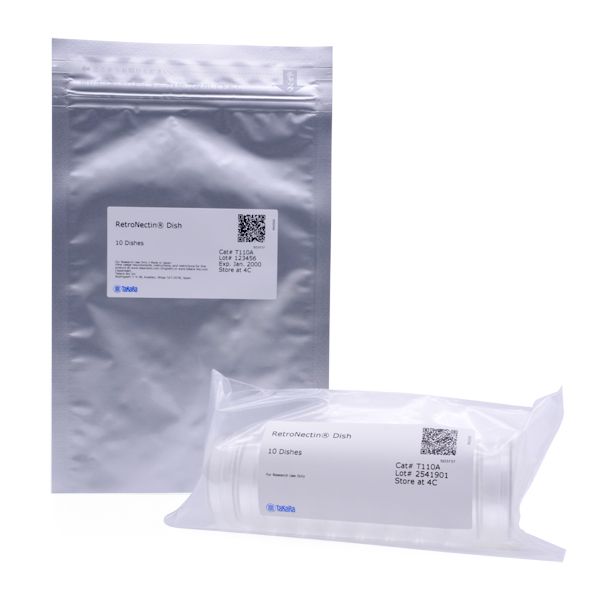RetroNectin Precoated Dish
RetroNectin Precoated Dish
RetroNectin Precoated Dish
Pack of ten 35 mm dishes that are pre-coated with RetronNectin reagent. RetroNectin reagent is a 63 kD fragment of recombinant human fibronectin fragment (also referred to as rFN-CH-296) that enhances the efficiency of lentiviral- and retroviral-mediated gene transduction. This is particularly important for hematopoietic cells and other hard-to-transfect cell types. Enhanced transduction is thought to result from co-localization of virus particles and target cells. This is accomplished by direct binding of viral particles to sequences in the heparin-binding domain and interaction of target-cell integrins with two other domains in rFN-CH-296.
Overview
- Enhanced gene transfer efficiency for retroviral or lentiviral transduction of suspension cells, hematopoietic stem cells, and other hard-to-infect cell types
- Less toxicity than other commonly used transduction enhancers, including polybrene and protamine
- Fully recombinant peptide
- Cat. # T110A consists of ten 35-mm dishes pre-coated with RetroNectin reagent
- The efficiency of T cell (CD8+) expansion can be significantly increased in the presence of RetroNectin reagent
Applications
- Enhanced retroviral or lentiviral mediated transduction of cells that express VLA-4 or VLA-5 (including many hematopoietic cell types)
- In vitro T-cell expansion of CD8+ cells
- RetroNectin reagent has been used in over 40 clinical trials
- Research-grade RetroNectin (Cat. # T100A/B; T110A): For research use only. Not for use in diagnostic or therapeutic procedures.
Schematic protocol for infecting target cells using RetroNectin

Schematic protocol for infecting target cells using RetroNectin reagent. In the RBV (RetroNectin-bound virus) method, the retrovirus is first bound to the RetroNectin-coated plate, and cells are added after removing the retrovirus supernatant. In this protocol, removal of the supernatant reduces inhibitory molecules that otherwise can reduce the transduction efficiency.
Comparison of T cell expansion efficiencies for various commonly used protocols

Comparison of T cell expansion efficiencies for various commonly used protocols. Cells co-stimulated using RetroNectin and α-CD3 demonstrated higher-fold expansion as compared to other protocols (Panel A). In addition, the presence of RetroNectin promoted the production of more naïve-like T cells (CCR7+/CD45RA+ phenotype) that have been shown to have better in vivo anti-tumor activity (Panel B).
NOTE: This expansion method requires a license for commercial applications.
Comparison of retroviral transduction of a K562 cell line using transduction enhancers from different companies

Comparison of retroviral transduction of a K562 cell line using transduction enhancers from different companies. A K562 cell line was transduced with a retroviral vector in the presence of various transduction enhancers. RetroNectin yielded a far higher transduction efficiency relative to each of the other transduction enhancers, including Polybrene, protamine sulfate, and human fibronectin from three other companies.
Efficient transduction of human PBMCs using RetroNectin, as compared to Polybrene

Efficient transduction of human PBMCs using RetroNectin, as compared to Polybrene. Human PBMCs were transduced with varying dilutions of lentivirus encoding ZsGreen1 in the presence of RetroNectin or Polybrene, and the percentages of transduced CD8+ cells were measured by flow cytometry. Transduction efficiencies with Retronectin were significantly higher than those obtained using Polybrene, especially at low MOI (90X dilution).


